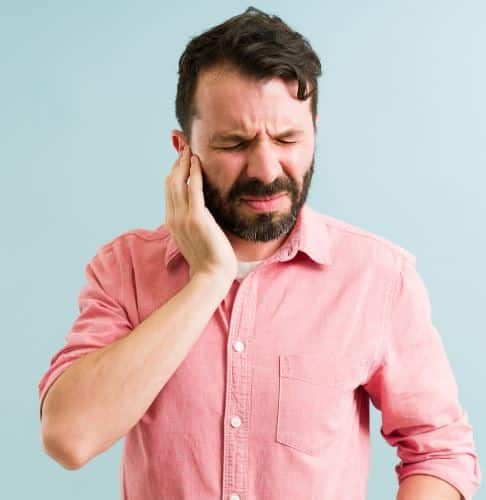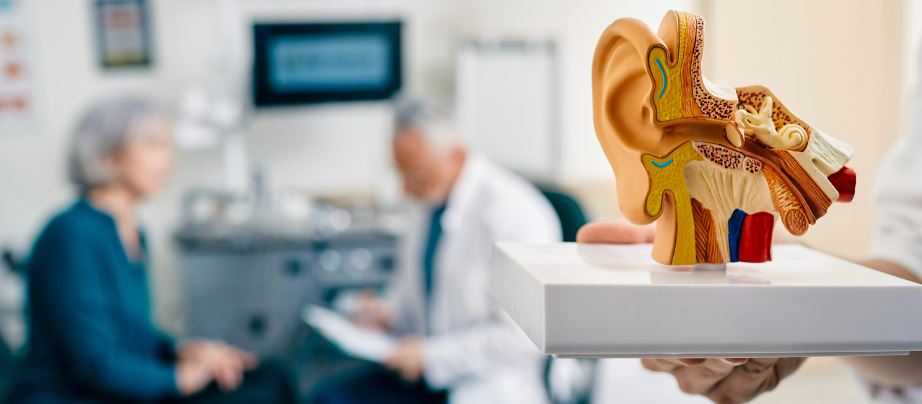by Michael Piskosz & Bill Schiffmiller
Don’t worry, this isn’t another article that will barrage you with tinnitus statistics, facts, and figures. We see them non-stop and there are plenty of places to find them. Let’s be honest—these figures are nothing more than technical talking points that have very little influence on the real problem. These statistics don’t move the industry needle, they create imaginary total addressable markets (TAM), and they mean zilch to consumers dealing with tinnitus at the moment. Instead, this article is designed to make you think critically about why audiology has not been able to crack the tinnitus code or provide adequate help to the millions of people struggling with tinnitus, and how to create the change we need.
I’m Michael Piskosz, an audiologist with over 25 years of experience in the hearing healthcare industry. As a globally recognized expert on tinnitus, I have successfully developed and launched multiple products designed to improve both hearing and tinnitus management. The founder of Akoio, Bill Schiffmiller and I have been monitoring and analyzing the business and care of tinnitus, here’s our assessment and what the future holds for tinnitus.
The Uncracked Code of Tinnitus Solutions
 Although hundreds of millions of people suffer from tinnitus globally, nobody has been able to crack the code to a solution for the masses. Audiology, as a field, has not claimed this as an area of expertise, leading to a lack of authoritative guidance for those affected. This gap has left many patients to fend for themselves, seeking out whatever solutions they can find, often with mixed results.
Although hundreds of millions of people suffer from tinnitus globally, nobody has been able to crack the code to a solution for the masses. Audiology, as a field, has not claimed this as an area of expertise, leading to a lack of authoritative guidance for those affected. This gap has left many patients to fend for themselves, seeking out whatever solutions they can find, often with mixed results.
One of the biggest issues is that far too few audiologists are getting their ‘hands dirty’ with the tinnitus population. Tinnitus remains an underserved market, and under the current service models, it will continue to be so.
Historical Neglect of Tinnitus in Audiology
Audiologists have only recently begun to take tinnitus seriously as part of overall auditory health. For too long, tinnitus laid in the background, creating no awareness for the general population and offering little help to those in need. This historical neglect has resulted in a general lack of understanding and support for tinnitus sufferers.
Additionally, it’s time to reassess our industry leaders and their impact on progress. Tinnitus conferences frequently present repetitive research with minimal new insights and limited practical applications for the public. These gatherings often resemble high-school reunions for researchers rather than hubs for groundbreaking advancements. To achieve real progress, we need fresh perspectives and innovative leaders dedicated to making a tangible difference for those affected by tinnitus and bold enough to think outside the box.
The Tech Trap
The field of audiology has traditionally relied heavily on products and technology to drive tinnitus services. While these products can be helpful tools, they should not be the sole driving force. The focus on technology often overlooks the importance of personalized care and professional guidance, which are crucial for managing a condition as individualized as tinnitus.
The market has seen an influx of tech companies introducing new tinnitus solutions. From sound therapy apps to multi-modal solutions and innovative hearing aids designed to mask or reduce the perception of tinnitus, the options are expanding. However, despite the surge in technology, nobody has cracked the commercial code. These solutions often come with big promises but fall short on delivering sustainable, long-term relief and greater consumer awareness.
Missing the Mark: Why Tinnitus Relief Eludes the Many
Why hasn’t any product, technology, or company been able to penetrate this population in need? The answer lies in the nature of tinnitus itself. Tinnitus is not a one-size-fits-all condition; it varies greatly from person to person. This variability makes it challenging to develop a universally effective solution. Additionally, the market is fragmented, with numerous players offering similar products and services, which can confuse consumers and dilute efforts to create significant impact.
Another reason is a lack of an identifiable consumer price point as reference makes it difficult for companies to price their product attractively for consumers. Some consumers are willing to pay significant amounts of money for relief, while others are reluctant to spend at all, often due to previous experiences with scams and quick fix solutions or prioritizing other personal expenses. This skepticism can make it difficult to establish trust and convince consumers to see value and invest in legitimate, long-term solutions.
Additionally, using tinnitus as a window to sell hearing aids has continually failed because it misaligns tinnitus sufferers’ primary needs and concerns. This approach can be untrusting to patients as they are being sold a solution that does not directly address their specific problem, further complicating the relationship between audiologists and tinnitus sufferers.
Lastly, those with distressing or debilitating tinnitus require a lot of ‘hand-holding’, this makes up 2% of the population, according to the American Tinnitus Association (ATA).* Truth is, these numbers are loose estimates at best – nobody has an accurate number. However, if you build products for this 2% (the few), you miss the real opportunity with tinnitus, which is the majority who do not suffer to this degree. Building for the few limits your ability to scale to the many as your product or service becomes too burdensome or disconnected from their needs. They don’t want to commit to the time commitment of your solution. They want to do it on their time on their terms.
Catering to the small population with high needs demands significant time, resources, and flexibility. These individuals often need extensive human counseling and discussion, which conflicts with the efficiency of automated digital business models.
According to the Apple Hearing Study – Tinnitus (2024), the majority of participants reported their tinnitus was faint, with only 8.8% reporting it to be loud or ultra loud.** This supports the notion that the real commercial opportunities are in the many, not the few. The company that designs solutions for the broad market while still addressing the needs of specific individuals will have the best chance of succeeding in the tinnitus industry.
This shows that most people who experience tinnitus don’t suffer from it. Rather, it’s an occasional annoyance. We don’t need to exacerbate the problem to them, and for many of the occasional tinnitus sufferers, self-guiding, AI-based platforms can be very helpful, just like apps that help people lose weight or reduce stress. Of course, we know tinnitus can be an early sign of auditory damage, so it should be promoted as part of overall auditory and hearing health and not be thought of in isolation. However, for many people who are occasionally annoyed by it, future technologies will give them access to help on their terms, to fit their schedules.
The hearing healthcare industry should embrace these new technologies, allowing it to be a more flexible, comprehensive and dynamic industry, benefiting clinicians and customers alike.
The Three Business Models for Tinnitus Solutions
There have been three primary business models for tinnitus solutions: Audiology, Direct to Consumer (DTC), and a hybrid of the two.
Audiology Model: Tinnitus product is delivered only through licensed audiologist
Pros:
-
- Offers professional service and personalized care tailored to the individual’s specific needs.
- Utilizes the expertise of licensed audiologists, ensuring a high standard of treatment and support.
Cons:
-
- Typically involves expensive hardware, which can be a significant financial burden for patients.
- Limited number of providers, making access to care challenging for many individuals.
- The real total addressable market is often overestimated, as clinics cannot continually fit multiple devices for the same patient, leading to a saturated local market and reduced long-term demand.
Direct to Consumer (DTC) Model: Tinnitus product is delivered through DTC platform
Pros:
-
- Self-guided, allowing individuals to manage their treatment at their own pace and convenience.
- Highly accessible, with products and services often available online, reaching a broader audience.
- Generally, more affordable than the audiology model, reducing financial barriers to entry.
Cons:
-
- Lack of professional guidance can lead to suboptimal treatment outcomes and reduced efficacy.
- Creating consumer awareness and trust is challenging, particularly in a market flooded with similar products.
- Difficulty in ensuring the long-term commitment of users, as the absence of professional oversight can lead to inconsistent adherence to treatment protocols.
Hybrid Model: Tinnitus product is delivered through both audiology and DTC options
Pros:
-
- Combines elements of both audiology and DTC models, offering a balance of professional guidance and accessibility.
- Can leverage the strengths of both approaches, potentially providing a more comprehensive and flexible solution.
Cons:
-
- Still faces the challenge of limited professional guidance in the DTC component, which can impact treatment effectiveness.
- High costs associated with the audiology component may deter some users, despite the added benefits.
- Managing and integrating both models can be complex, requiring significant resources and coordination.
Challenges of the Audiology Model
Companies that choose the audiology-only route often do well in the beginning years but quickly find themselves struggling. They face challenges such as a lack of a growing provider network, insufficient innovation, spreading resources too thinly, and not providing multiple consumer touchpoints. Once the initial excitement wears off, sustaining revenue becomes very difficult.
This model often fails to accurately account for the total addressable market for tinnitus solutions. Regarding tinnitus, clinics cannot regularly fit multiple devices for the same customer over an extended period. The local population with distressing tinnitus looking to act on it is far and few, and once served, the demand for new devices diminishes. Unlike hearing health and updating hearing aids, when habituation for tinnitus is successful, that population will unlikely require further tinnitus services. This demand reduction directly impacts the clinic’s ability to move products consistently and sustainably, ultimately affecting the company’s bottom line.

Challenges of the DTC and Hybrid Models
Companies adopting DTC models often struggle with raising consumer awareness, generating sustained interest via effective marketing campaigns, and securing long-term consumer commitment. Developing a revenue model that can scale both monetarily and promotionally is challenging. Many digital platforms offer similar programs with slight nuances and different user interfaces, making it hard for consumers to see true differentiation. Furthermore, the digital competition is intensifying, and many new entrants are likely to repeat the same errors that led to the downfall of their predecessors.
Using a hybrid model for tinnitus treatments presents a significant challenge in effectively coordinating the Direct-to-Consumer (DTC) and audiology components. Balancing seamless integration between self-guided digital tools and professional audiological guidance can lead to logistical complexities and inconsistencies in patient care.
The Roller Coaster of Tinnitus Solutions
We will most likely continue to see the roller coaster trend of the shiny new object followed by a quick fade. This cycle persists because many companies rely on conventional hearing aid industry business models, which do not apply to tinnitus as much as one might think, and these models are vulnerable to industry disruptors. Additionally, until the hearing healthcare industry, or some other sector, creates better consumer awareness and education, and takes ownership of this service, tinnitus will continue to exist in a murky consumer space.
Despite these challenges, the future is bright. Advancing technology holds promise for the tinnitus population. Innovations in artificial intelligence (AI), large language models (LLMs), and automated chat systems will allow forward-thinking companies to build technology that includes both tools to help distract the brain from tinnitus and automated guidance to offer users what they need. These self-guided technologies will allow people to create plans and schedules that work best for them, while still obtaining credible information and guidance.
For those who struggle with severely disruptive tinnitus, human touch remains crucial. Audiologists should ensure they are the professionals providing this much-needed support, complementing technological solutions, with their expertise and empathy.
Conclusion
Hearing healthcare has yet to fully embrace tinnitus as a central part of auditory health, leading to gaps in awareness and service provision. The overreliance on products and technology without sufficient professional guidance has compounded these issues. While business models in the field have their pros and cons, none have yet to effectively address the needs of the tinnitus population comprehensively and on a large commercial scale.
However, the future holds promise. With the advancement of AI and other technologies, and a renewed commitment from the hearing healthcare industry to provide personalized care, there is potential to significantly improve the lives of those suffering from tinnitus. It’s time for the industry to take tinnitus seriously and offer the support that millions desperately need.
In the end, the ringing in patients’ ears is a call to action—one that the hearing healthcare community must answer with forward-thinking, innovative technology, and compassionate care.
**https://www.ata.org/about-tinnitus/why-are-my-ears-ringing/
**https://www.apple.com/newsroom/2024/05/apple-hearing-study-shares-preliminary-insights-on-tinnitus/
About the Authors
Bill Schiffmiller is Founder and CEO of Akoio®, a premier auditory wellness company. Bill’s experience includes serving as the former Leader of Accessibility Initiatives at Apple, Inc. In this role, he developed inclusive and accessible solutions integrated into Apple’s global corporate and retail operations. His work in advocacy, customer service, and experience significantly enhanced the Apple brand, setting new standards for accessibility. Bill, a lifelong hearing aid user, is driven by a humanistic philosophy and a commitment to positively impacting lives through sound management and accessibility solutions. His mantra, “Lifelong Sound Health for all,” reflects his dedication not only to those with hearing loss but to everyone.
Michael Piskosz is Director of Research and Client Relations at Akoio®. With over 25 years of experience in the hearing aid manufacturing and audiology industries, Michael has dedicated his career to identifying consumer needs, developing products and services to meet those needs, and driving innovation through creativity and ideation. He deeply desires to transform auditory health, stepping away from conventional limitations and unlocking the vast array of opportunities the industry currently overlooks. Michael’s work is driven by a commitment to improving lives through innovative auditory health solutions, blending technical expertise with a deep understanding of human behavior to create impactful products and services.






